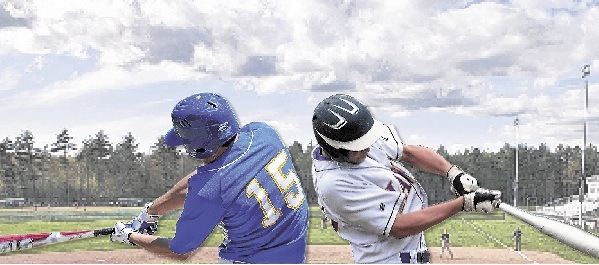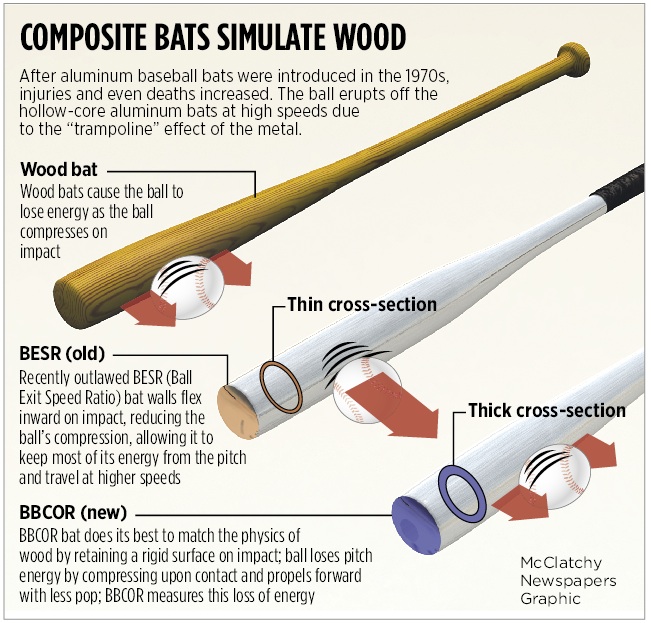It’s the fear that every pitcher tries to put out of mind — the baseball coming so sharply off the bat there is not enough time to react.
Ben Salley, a sophomore pitcher for Skowhegan High School, was hit in the face with a batted ball two weeks ago in a game against Mt. Ararat. He was left with a large bruise, but it could have been a lot worse, especially if the batter had been swinging an aluminum bat.
Prior to this season, the National Federation of State High School Associations outlawed aluminum baseball bats in favor of a less explosive version. The change was primarily done for safety, but there has also been a significant impact on the game — less offense, fewer home runs and extra-base hits, lower earned-run averages for pitchers.
The new bats have less of a trampoline effect than aluminum, and Salley is thankful. While he said he didn’t have enough time to react to the ball hit at him, he would have had less time had it been hit with an aluminum bat, and the ball would have struck his face with greater force.
Salley said he blacked out for a couple of seconds when he was hit in the jaw, but somehow the impact didn’t break any bones, and he was back pitching five days later.
“It might have been a different outcome with an aluminum bat. I could have had a broken jaw or a concussion. I was lucky,” said Salley, who knows a couple inches would have made a major difference. “If it had hit me in the cheek, the eye or the temple, it would have been a lot worse.”
If you can call being hit in the face with a batted ball lucky, then Salley qualifies. The fact it was done with a BBCOR bat — which stands for Batted Ball Coefficient of Restitution, a fancy name for measuring the loss of energy when a ball comes off the bat — rather than with an aluminum bat could have made all the difference.
In the past, the high school federation used an equation for bats called Ball Exit Speed Ratio, or BESR, to determine the standards. Safety concerns mounted when some studies found that balls were coming off the bats at speeds of up to 125 mph or faster, with pitchers and corner infielders only 60 to 90 feet away.
“I’m 100 percent sure that if we had been using the old bats it would have ended differently,” said Skowhegan Coach Rick York.
SEVERE INJURIES, EVEN DEATH
When facing hitters using aluminum bats, others haven’t been as fortunate. There have been severe injuries to pitchers, and even a death. In 2003, a pitcher in Montana died after being hit in the head from a batted ball. His family sued Hillerich and Bradsby, the bat maker, and were awarded $850,000. The family argued that aluminum bats are dangerous because they cause the baseball to travel at a greater speed. They said their son didn’t have enough time to react to the ball before it struck him.
With BBCOR bats, the ball travels at a slower speed after being struck. Less speed increases pitcher safety, but decreases the distance the ball will travel.
Along with the safety factor, the other effect of BBCOR bats on high school baseball is less offense. Home runs, triples and doubles are down, fewer runs are being scored, and the game has become more defensive. It’s not because the hitters are less talented or the pitchers are better, it’s because the bats — to put it simply — have less oomph.
AVERAGES, SCORES DROP
College baseball made the change to BBCOR bats for the 2011 season. Last season, Division I college hitters nationally had a composite batting average of .282, the lowest since 1976. In 2010, the batting average was .305 using aluminum. Scoring in 2011 also was the lowest since 1975. Home runs per game were also down along with the pitchers’ ERA.
Steve Trimper, coach of the University of Maine baseball team, said the Black Bears have had to change their offense because of the lack of the long ball.
“It’s been a dramatic difference,” said Trimper. “I’m not a big fan of the sacrifice bunt, but we’ve had to do more of it. We’re doing more hit-and-run and stealing of bases. You have to find a way to get runners in scoring position.
“No longer can you hope for your ninth batter hitting a three-run homer. Sacrifice bunts are up 60 percent in college baseball. It’s been shown that the ball travels 20 to 30 feet less with the BBCOR bats. A home run that cleared the fence by 10 feet before is now a fly ball out.”
‘DRASTIC DECLINE IN HOME RUNS’
In his team’s opening game against Falmouth High, Alex Mercurio, a rugged catcher for York High, timed a pitch perfectly and sent the ball on a line drive to right center. Last season, Mercurio’s shot would have easily cleared the fence at York for a home run. This time it was an out and served as an indicator that fewer long balls would be hit this season.
“It would have been halfway up in the trees a year ago,” said York Coach Tony Robinson, who added that the Wildcats’ field is hitter-friendly because it has short fences. “Our pitchers have allowed one home run this season and we’ve hit only one. There’s been a drastic decline in home runs all around. You have to play more small ball. It’s sort of become like old-time baseball with pitching and defense. We’ve hit a lot of balls hard that would have been hits with the old bats.”
In the Telegram League — which includes the largest schools in western Maine — Ben Wessel of Scarborough led all hitters in home runs with two. Seventeen players are tied with one home run, so this season’s long ball hasn’t been as long.
Taylor Reuillard of Biddeford won last year’s Telly League home run title with four, and seven players tied with two homers. Reuillard has one home run this season.
Every league in the state has seen a decline in offensive production.
“We had a couple of balls crushed that were fly ball outs,” said Freeport High School Coach Hank Ogilby.
Andrew Emple of Falmouth High School is one player who likes the new bats. He has three of his team’s four home runs. A year ago, Falmouth hit nine home runs. Other Falmouth stats are revealing when comparing last year’s bats to this year’s version. Falmouth’s pitchers had a 3.40 ERA in 2011. It’s 1.49 this season. Opponents batted .236 against Falmouth pitching last season. This year, opponents are batting .166.
“It’s the same for everyone,” said Falmouth Coach Kevin Winship. “Offensive production is down. The sweet spot on the new bats is a lot less. There’s less margin for error.”
SWITCHING BACK TO WOOD
The new bats aren’t exactly marshmallows. The ball will travel if hit properly, but it requires a good batting eye.
“It teaches you to hit the ball well,” said Pete Stauber, Greely’s catcher. “You really have to time the pitches. When you hit the sweet spot, it’s a better feeling. When you get jammed, you can feel it.”
Sounds just like a wooden bat, which aluminum bats replaced in the 1970s because of the cost. Stauber, who also said he likes the sound of wood, is one of three Greely players who switched to wooden bats in games just past the halfway point of this season.
“The players were so frustrated with the new bats that they switched to wood,” said Greely Coach Derek Soule. “If they feel more confident using wood then I’m all for it. Will McAdoo is one of the players who switched to wood. He’s batting .364. There appears to be no difference in the distance the ball travels with wood versus BBCOR. My son uses a maple wood bat on his eighth-grade team and feels the ball carries better than the new bats.
“The game is more defensive-oriented this season,” said Ogilby. “That’s OK with me.”
– McClatchy News Service contributed to this report
Staff Writer Tom Chard can be reached at 791-6419 or at:
tchard@pressherald.com
Send questions/comments to the editors.





Comments are no longer available on this story